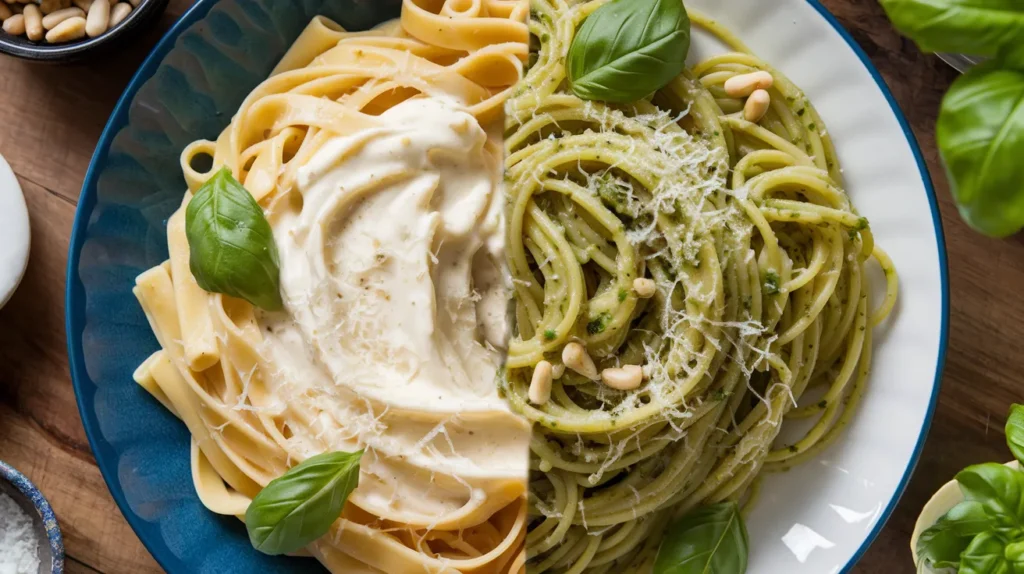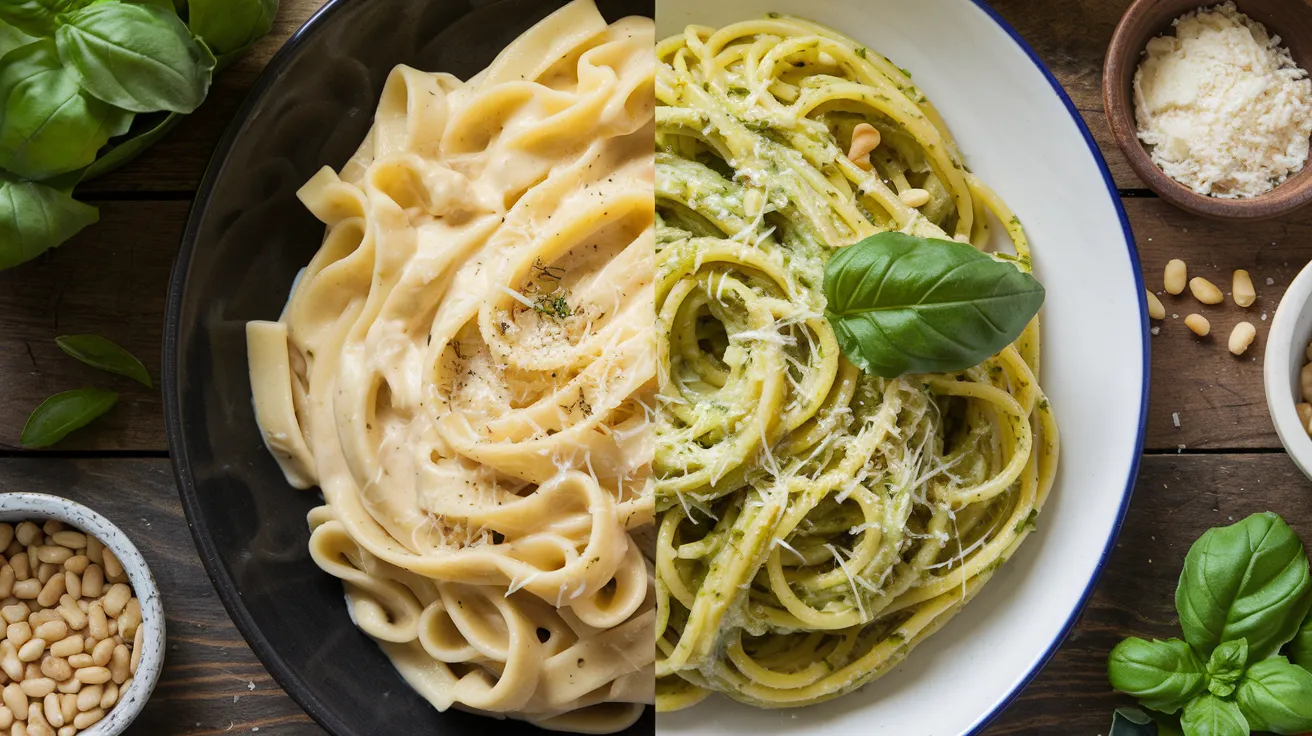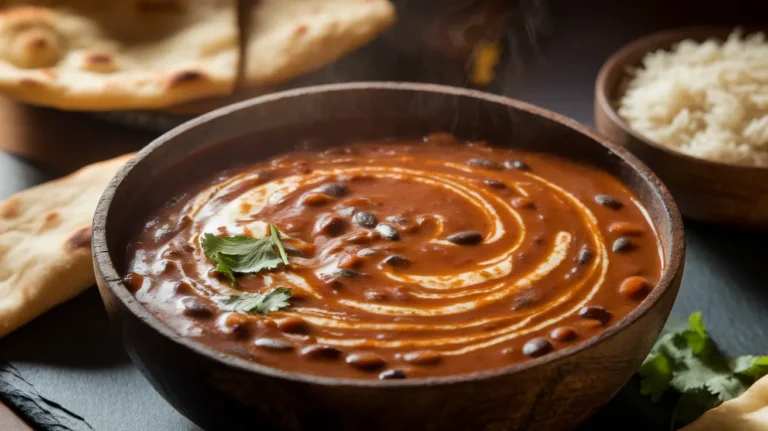Key Takeaways:
- Create two Italian classics in under 30 minutes from scratch
- Perfect for pasta nights when you want variety on your plate
- Learn fundamental sauce-making skills that apply to countless recipes
- Easily adapt for dietary needs with simple ingredient swaps
Two Classic Sauces, One Incredible Meal
Standing in your kitchen, torn between creamy Alfredo or vibrant pesto for dinner? Now you don’t have to choose! This Alfredo and Pesto Sauce recipe delivers both options sized perfectly for a family of four.
With this Alfredo and Pesto Sauce guide, you’ll create authentic, restaurant-quality sauces from scratch using fresh ingredients and beginner-friendly techniques. These homemade versions put store-bought jars to shame and take just minutes to prepare.
The creamy richness of Alfredo sauce paired with the bright, herbaceous pesto sauce offers perfect contrast. Serve them separately, create a stunning two-tone pasta presentation, or mix them for an entirely new flavor experience. Ready to transform ordinary pasta night into something special? Let’s start cooking!
Nutrition Comparison of Alfredo and Pesto Sauce
| Nutrient (per 1/4 cup serving) | Alfredo Sauce | Pesto Sauce |
|---|---|---|
| Calories | 320 | 265 |
| Total Fat | 32g | 27g |
| Saturated Fat | 20g | 5g |
| Carbohydrates | 3g | 2g |
| Protein | 8g | 6g |
| Sodium | 450mg | 320mg |
| Vitamin A | 15% DV | 10% DV |
| Calcium | 20% DV | 15% DV |
Note: Nutritional values are approximate and may vary based on specific brands of ingredients used.
What You’ll Need for Alfredo and Pesto Sauce
Complete Ingredients List
For the Alfredo Sauce (Serves 4)
| Ingredient | Amount |
|---|---|
| Butter (unsalted) | 6 tablespoons |
| Heavy cream | 1 cup |
| Garlic cloves | 2, minced |
| Parmesan cheese | 1½ cups, freshly grated |
| Salt | ½ teaspoon |
| Black pepper | ¼ teaspoon |
| Nutmeg (optional) | Pinch |
For the Pesto Sauce (Serves 4)
| Ingredient | Amount |
|---|---|
| Fresh basil leaves | 2 cups, packed |
| Pine nuts | ⅓ cup |
| Garlic cloves | 2-3, peeled |
| Parmesan cheese | ½ cup, freshly grated |
| Extra virgin olive oil | ⅔ cup |
| Salt | ¼ teaspoon |
| Black pepper | ¼ teaspoon |
| Lemon juice | 1 teaspoon (optional) |
Essential Kitchen Tools
| Tool | Purpose |
|---|---|
| Food processor or blender | For making pesto |
| Medium saucepan | For Alfredo sauce |
| Wooden spoon | For stirring Alfredo sauce |
| Silicone spatula | For scraping down processor sides |
| Measuring cups and spoons | For accurate measurements |
| Microplane or cheese grater | For freshly grating cheese |
| Cutting board and sharp knife | For prep work |
| Small skillet | For toasting pine nuts (optional) |
| Storage containers | For leftovers |
Possible Substitutions for Dietary Needs
For Alfredo Sauce:
- Dairy-free option: Substitute butter with plant-based butter and heavy cream with full-fat coconut milk
- Lighter version: Use half-and-half instead of heavy cream (reduces calories by about 30%)
- Cheese variations: Romano cheese can replace some or all of the Parmesan
- Gluten concerns: This sauce is naturally gluten-free (but check cheese labels)
For Pesto Sauce:
- Nut allergies: Use sunflower seeds or pumpkin seeds instead of pine nuts
- Budget option: Walnuts make a great substitute for expensive pine nuts
- Herb variations: Try half basil, half spinach for a milder flavor
- Oil options: Part of the olive oil can be replaced with avocado oil
- Vegan adaptation: Use nutritional yeast instead of Parmesan
Total Preparation Time for Alfredo and Pesto Sauce
- Prep Time: 10 minutes
- Cook Time: 15 minutes (Alfredo) / 5 minutes (Pesto)
- Total Time: 20-25 minutes
Detailed Step-by-Step Instructions for Beginners
Preparing Classic Alfredo Sauce
- Set up your workstation properly
- Clear counter space for comfortable working
- Read through entire recipe before starting
- Measure all ingredients and place in small bowls
- Grate cheese freshly (pre-shredded cheese contains anti-caking agents that affect texture)
- Mince garlic cloves finely and remove any green sprouts (which can taste bitter)
- Have a timer nearby
- Melt the butter properly
- Place medium saucepan on stove
- Set heat to medium-low (position 3-4 on most dials)
- Add 6 tablespoons butter to cold pan
- Allow butter to melt completely (about 2-3 minutes)
- Look for butter to become fully liquid but not brown
- If butter starts to sizzle strongly, reduce heat immediately
- Add garlic to build flavor base
- Once butter is completely melted, add minced garlic
- Stir continuously with wooden spoon
- Cook for exactly 60 seconds until fragrant
- Watch carefully to prevent garlic from browning (which causes bitterness)
- Keep heat low—burnt garlic will ruin your sauce
- Incorporate cream properly
- While continuing to stir, slowly pour in 1 cup heavy cream
- Pour in a steady stream while stirring (not all at once)
- Increase heat to medium (position 5 on most dials)
- Watch for small bubbles forming around edges of pan
- These bubbles indicate the mixture is approaching a simmer
- IMPORTANT: Do not let it reach a full boil (rapid bubbling)
- Reduce sauce to proper consistency
- Once small bubbles appear around edges, set timer for 5 minutes
- Stir occasionally (every 30 seconds) to prevent skin forming
- Watch as sauce gradually thickens
- Test thickness by dipping wooden spoon in sauce
- Run your finger across back of spoon—if it leaves a clear path, sauce is reducing properly
- If bubbling becomes vigorous, reduce heat immediately
- You want gentle bubbling, not rapid boiling
- Add cheese correctly for smooth texture
- After 5 minutes, turn heat to lowest setting
- Remove pan from heat completely
- Add grated Parmesan cheese in three equal portions
- Stir thoroughly after each addition until completely melted
- Use figure-eight motion while stirring to incorporate air
- If cheese isn’t melting fully, return to very low heat briefly
- Add ½ teaspoon salt, ¼ teaspoon black pepper, and pinch of nutmeg (if using)
- Stir again to distribute seasonings evenly
- Perform final consistency check
- Sauce should coat back of spoon thickly but still be pourable
- If too thick (like pudding): Add 1-2 tablespoons warm pasta water and stir
- If too thin (like milk): Return to low heat for 1-2 more minutes, stirring constantly
- Taste and adjust seasonings if needed
- Remember: Sauce will thicken slightly more as it cools
- Keep warm on lowest heat setting until ready to use
Preparing Fresh Pesto Sauce
- Properly prepare basil leaves
- Gently remove basil leaves from stems
- Measure 2 packed cups (approximately 2 large bunches)
- Fill bowl with cold water and swish leaves gently
- Lift leaves out (don’t pour water over them)
- Spread on clean kitchen towel or paper towels
- Pat completely dry (VERY IMPORTANT: water will make pesto watery)
- Inspect leaves and discard any that are brown or damaged
- Toast pine nuts for enhanced flavor
- Place dry skillet on stove (no oil needed)
- Set heat to medium-low (position 3-4 on most dials)
- Add ⅓ cup pine nuts to cold skillet
- Spread in single layer
- Set timer for 4 minutes
- Shake pan or stir with wooden spoon every 30 seconds
- Watch carefully—pine nuts burn quickly due to high oil content
- Look for light golden color and fragrant smell
- Remove immediately from hot pan to prevent over-toasting
- Transfer to plate and let cool for 5 minutes before using
- Set up food processor correctly
- Ensure food processor bowl and blade are completely clean and dry
- Attach blade according to manufacturer’s instructions
- Have all ingredients measured and within reach
- Have spatula ready for scraping sides
- Remove jewelry from hands if necessary
- Combine dry ingredients properly
- Place dry basil leaves in processor bowl
- Add cooled pine nuts
- Add 2-3 peeled garlic cloves (2 for mild, 3 for stronger flavor)
- Secure lid properly
- Pulse 6-8 times in short bursts (1-2 seconds each)
- Stop and remove lid
- Scrape down sides with rubber spatula
- Mixture should be coarsely chopped but not pureed
- Add cheese and seasonings correctly
- Add ½ cup freshly grated Parmesan
- Add ¼ teaspoon salt
- Add ¼ teaspoon black pepper
- Secure lid
- Pulse 3-4 more times (1-2 seconds each)
- Scrape down sides again
- Incorporate oil with proper technique
- Secure lid with feed tube open
- Start processor running on low speed (not pulse)
- Measure ⅔ cup olive oil in measuring cup with pour spout
- Very slowly drizzle oil through feed tube while machine runs
- This should take about 30 seconds (not all at once!)
- Watch consistency through clear processor bowl
- Stop machine after all oil is added
- Remove lid and scrape down sides
- Make final adjustments for perfect pesto
- Check consistency—should be thick but slightly flowing
- If too thick: Add 1-2 additional tablespoons olive oil and pulse
- If too thin: Add 1-2 tablespoons more cheese or a few more basil leaves
- Add 1 teaspoon lemon juice if using (helps maintain bright green color)
- Pulse 2-3 more times to incorporate
- Taste on tip of spoon
- Adjust salt and pepper if needed
- Transfer to serving bowl immediately
Serving Your Homemade Alfredo and Pesto Sauce
- Classic Individual Serving Method
- Cook 1 pound pasta according to package directions (reserve ½ cup pasta water)
- Divide cooked pasta into two equal portions
- Toss first portion with warm Alfredo sauce
- Toss second portion with fresh pesto sauce
- For Alfredo pasta: Garnish with cracked black pepper and chopped parsley
- For pesto pasta: Garnish with extra pine nuts and small basil leaves
- Serve immediately on warmed plates
- Stunning Dual-Sauce Presentation
- Cook 1 pound pasta and drain (reserve ½ cup pasta water)
- Divide pasta into two separate bowls
- Toss each portion with one sauce
- On large serving platter, arrange Alfredo pasta on one side
- Arrange pesto pasta beside it, creating distinct two-tone effect
- Create wavy line between sauces for visual appeal
- Garnish each side appropriately
- Provide serving tongs or pasta server
- Creative Swirl Method (Impressive for Guests)
- Toss most of cooked pasta with Alfredo sauce
- Add 1-2 tablespoons pasta water if needed to loosen
- Divide into individual serving bowls
- Place pesto in small squeeze bottle or piping bag
- Swirl pesto decoratively on top of Alfredo pasta
- Use toothpick to create design if desired
- Garnish with single basil leaf
- Serve immediately
- Best Pasta Shapes for These Sauces
- For Alfredo Sauce: Fettuccine (traditional), linguine, pappardelle, or wide egg noodles
- For Pesto Sauce: Spaghetti, fusilli, farfalle (bow ties), or trofie (traditional Ligurian pasta)
- For dual presentation: Medium shapes like penne or rotini work well for both
Troubleshooting Common Issues with Alfredo and Pesto Sauce
Alfredo Sauce Problems and Solutions
Problem: My sauce is too thin and runny
- Solution: Continue simmering on low heat for 2-3 more minutes, stirring constantly
- Step-by-step fix: Remove from heat, let cool for 1 minute, return to low heat, simmer while stirring
- Prevention: Be patient during the reduction step; different brands of cream may need different reduction times
Problem: My sauce is too thick and gloppy
- Solution: Add warm (not cold) pasta water, 1 tablespoon at a time, stirring after each addition
- Step-by-step fix: Add water, whisk vigorously, test consistency, repeat if needed
- Prevention: Always save some pasta cooking water when making any sauce
Problem: My cheese is clumping or the sauce looks grainy
- Solution: Remove from heat completely, add 2 tablespoons of warm cream, whisk vigorously
- Step-by-step fix: Whisk in small circles, gradually widening motion until smooth
- Prevention: Always use room temperature cheese, add gradually, and keep heat low
Problem: My sauce is separating or looks oily
- Solution: Transfer to blender, add 1 tablespoon cold cream, blend on low for 10 seconds
- Step-by-step fix: If no blender, whisk rapidly off heat with cold cream
- Prevention: Never let sauce boil; high heat breaks the emulsion

Pesto Sauce Problems and Solutions
Problem: My pesto is too thick to spread or toss with pasta
- Solution: Add more olive oil, 1 tablespoon at a time, pulsing briefly after each addition
- Step-by-step fix: Add oil, pulse 2-3 times, check consistency, repeat if needed
- Prevention: Reserve some oil to adjust consistency at the end
Problem: My pesto is too thin or watery
- Solution: Add 1-2 tablespoons more grated cheese plus a few more basil leaves, pulse briefly
- Step-by-step fix: Add ingredients, pulse 2-3 times, let sit 1 minute to absorb
- Prevention: Ensure basil leaves are completely dry; add oil very slowly
Problem: My pesto is turning brown quickly
- Solution: Add thin layer of olive oil on top when storing; add 1 teaspoon lemon juice
- Step-by-step fix: Pour oil to create 1/8-inch layer on surface; cover directly with plastic wrap
- Prevention: Always include lemon juice in recipe; minimize air exposure
Problem: My pesto tastes bitter
- Solution: Add 1/4 teaspoon sugar and small amount of extra salt
- Step-by-step fix: Add sugar, pulse once, taste, adjust if needed
- Prevention: Use young, fresh basil leaves; avoid basil with flowers; use high-quality olive oil
Creative Variations of Alfredo and Pesto Sauce
Alfredo Sauce Variations
- Roasted Garlic Alfredo
- Roast whole head of garlic at 400°F for 30 minutes until soft
- Squeeze 4-6 cloves into butter at beginning of recipe
- Reduce fresh garlic to 1 clove
- Creates deeper, sweeter garlic flavor
- Fresh Herb Alfredo
- Add 2 tablespoons total of fresh chopped herbs
- Try combination of parsley, chives, and thyme
- Add just before serving to preserve bright flavor
- Herbs should be very finely minced
- Protein-Enhanced Alfredo
- For chicken: Add ¾ cup diced cooked chicken (season with Italian herbs)
- For seafood: Add ½ pound sautéed shrimp or lump crab meat
- For meat lovers: Add 6 strips crumbled crispy bacon
- Add protein after sauce is complete; warm through gently
For more information on classic sauce foundations like Alfredo, check out this comprehensive guide on what are the base sauces every home cook should master.
Pesto Sauce Variations
- Sun-Dried Tomato Pesto
- Replace half the basil (1 cup) with ½ cup drained oil-packed sun-dried tomatoes
- Use the oil from the tomatoes as part of your olive oil measurement
- Increase garlic to 3 cloves for balanced flavor
- Add pinch of red pepper flakes for subtle heat
- Beginner-Friendly Spinach-Basil Pesto
- Use 1 cup basil and 1 cup baby spinach for milder flavor
- Spinach extends the pesto while reducing strong basil taste
- Perfect for children or picky eaters who find traditional pesto overwhelming
- Maintains bright green color longer than all-basil version
- Simple Dairy-Free Pesto
- Omit Parmesan cheese completely
- Add 2 tablespoons nutritional yeast for cheesy flavor
- Increase salt to ½ teaspoon to compensate
- Add 1 tablespoon lemon juice to brighten flavor
Proper Storage & Reheating of Alfredo and Pesto Sauce
Storing Alfredo Sauce Safely
- Refrigeration Method
- Allow sauce to cool at room temperature for no more than 30 minutes
- Transfer to clean airtight container using rubber spatula
- Press piece of plastic wrap directly onto surface of sauce (prevents skin formation)
- Secure lid tightly
- Label with date
- Refrigerate up to 3 days maximum (dairy sauces have shorter shelf life)
- Freezing Method (Emergency Option)
- Not ideal but possible for short-term storage
- Cool completely in refrigerator first
- Freeze in silicone ice cube trays for perfect portion control
- Once solid, transfer frozen cubes to freezer-safe zip-top bag
- Remove as much air as possible
- Label with date and contents
- Store up to 1 month
- Note: texture may change upon thawing (slight separation is normal)
Looking for a different approach to creamy pasta sauce? Try this delicious Alfredo sauce with evaporated milk for a lighter alternative that’s still incredibly creamy.
Storing Pesto Sauce Properly
- Refrigeration Method for Maximum Freshness
- Transfer to smallest container possible (minimize air exposure)
- Pour thin layer (¼ inch) of olive oil on top to seal surface
- This creates protective barrier against oxidation (browning)
- Secure lid tightly
- Refrigerate up to 5-7 days
- Stir oil back into pesto before using
- Freezing Method for Long-Term Storage
- For best results, freeze pesto without cheese
- Add cheese after thawing for fresher flavor
- Spoon into ice cube trays (about 2 tablespoons per compartment)
- Cover tray with plastic wrap
- Freeze until solid (about 2 hours)
- Transfer cubes to freezer bags
- Label with date and contents
- Store up to 3 months
- Thaw overnight in refrigerator or use frozen in cooking
Detailed Reheating Instructions
Reheating Alfredo Sauce Properly
- Stovetop Method (Preferred for Best Texture)
- Place refrigerated sauce in small saucepan
- Add 1-2 tablespoons of milk or cream per cup of sauce
- Set heat to low (position 2-3 on most dials)
- Warm very slowly, stirring constantly with whisk
- Heat only until just warmed through (about 3-4 minutes)
- Watch temperature carefully—never allow to bubble
- If sauce starts to separate, remove from heat immediately and whisk vigorously
- Test temperature before serving (should be just warm, not hot)
- Microwave Method (Quick Option for Small Portions)
- Transfer sauce to microwave-safe bowl
- Add 1 tablespoon milk or cream per cup of sauce
- Cover with microwave-safe lid or paper towel
- Heat in 20-second intervals at 50% power
- Stir thoroughly between each interval
- Continue until just warmed through
- Typically requires 3-4 intervals for 1 cup of sauce
- Whisk vigorously before serving
Serving Pesto Sauce After Storage
- Room Temperature Serving (Ideal Method)
- Remove from refrigerator 30 minutes before serving
- Stir thoroughly to reincorporate oil
- Never heat pesto on stovetop (destroys fresh flavor and color)
- If Using with Hot Pasta
- Place pesto in large serving bowl
- Add 2 tablespoons hot pasta water and stir
- This warms pesto slightly and helps it spread
- Add hot pasta directly to bowl and toss immediately
- Heat from pasta will warm pesto to perfect temperature
Essential Safety Notes & Pro Tips
Food Safety Guidelines
- Temperature danger zone: Never leave dairy-based Alfredo sauce at room temperature for more than 2 hours
- Cross-contamination prevention: Use separate cutting boards for herbs and any raw proteins
- Proper cooling: Cool Alfredo sauce within 2 hours before refrigerating
- Storage containers: Use glass or BPA-free plastic containers for acidic pesto sauce (prevents leaching)
- Cheese quality: Use freshly grated cheese—pre-shredded often contains anti-caking agents that affect texture
- Reheating safety: Reheat Alfredo sauce only once; never repeatedly reheat dairy sauces
Expert Preparation Tips for Perfect Results
- Mise en place importance: Measure and prepare all ingredients before starting either sauce
- Equipment quality: Sharp knives make herb prep easier, safer, and preserve more flavor
- Basil handling: Gently tear large basil leaves rather than cutting to prevent bruising
- Oil selection significance: Use high-quality extra virgin olive oil for pesto—it’s a primary flavor component
- Temperature control: Room temperature ingredients blend better for both sauces
- Cheese grating timing: Grate cheese just before using for best flavor and proper melting
- Garlic preparation: Let minced garlic rest 5-10 minutes before cooking to enhance health benefits
If you’re feeling adventurous and want to explore more sauce varieties beyond Italian classics, why not try this simple homemade curry sauce to expand your cooking repertoire?
Chef’s Final Notes on Alfredo and Pesto Sauce
Mastering these two classic Alfredo and Pesto sauces opens up endless possibilities in your kitchen. Remember that quality ingredients make all the difference—especially the cream and cheese for Alfredo and the basil and olive oil for pesto.
Don’t rush either sauce. The Alfredo sauce needs time to reduce properly, developing that signature velvety texture. The pesto sauce benefits from careful pulsing to maintain its rustic texture and vibrant color.
As you practice these recipes, you’ll develop an intuition for when each sauce reaches its perfect consistency. These foundational techniques build cooking skills that transfer to many other recipes, making you more confident in the kitchen.
The wonderful thing about mastering both Alfredo and pesto sauce in one session is versatility—you can serve them separately on different nights or together for an impressive dual presentation that satisfies everyone’s cravings. Whichever way you choose, your homemade sauces will elevate simple pasta into a memorable meal that brings restaurant quality to your dinner table.




